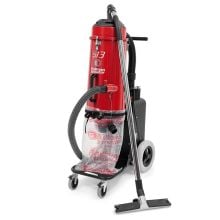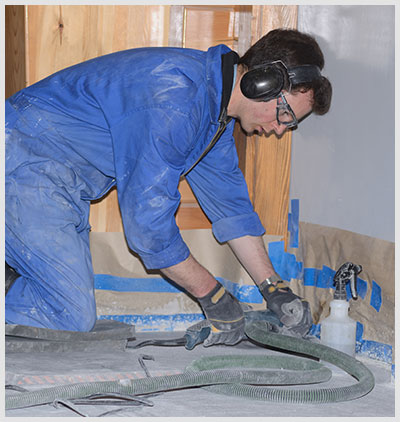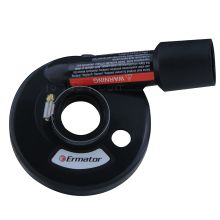OSHA-Compliant Handheld Grinders
Handheld Grinders: OSHA-Compliant Dust Control Methods
Handheld Grinding is covered in Table 1 (xii) of the regulation. According to the standard, you do not need to measure workers’ exposure to silica if any of following criteria is met:
1) Use a grinder equipped with an integrated water delivery system that continuously feeds water to the cutting surface. The integrated water delivery system can be a free-flowing water system designed for blade cooling as well as manufacturers’ systems designed for dust suppression alone.
Operate and maintain the tool in accordance with the manufacturer’s instructions to minimize dust emissions.
OR
2) Use a grinder equipped with a commercially available shroud and dust collection system.
Operate and maintain the tool in accordance with the manufacturer’s instructions to minimize dust emissions.
The dust collector must provide 25 cubic feet per minute (25 CFM) or greater of airflow per inch of wheel diameter and have a filter with 99% or greater efficiency and a cyclonic pre-separator or filter-cleaning mechanism.
Respiratory Protection:
If an integrated water delivery system is used, respiratory protection is not required, no matter how long the shift is.
If a shift is indoors or in an enclosed area AND more than four hours, respiratory protection of APF 10 must be provided.
Let’s Talk About Your Dust Collector...
How big does it need to be?
According to the rule above, your dust collector must provide 25 CFM for every inch of cutting blade. So if you’re using a 5-inch blade, you need a dust collector with at least 125 CFM. If you switch to a 7-inch blade, your dust collector must provide at least 175 CFM.
What about the filter?
OSHA’s new rule also requires that you use either
- a cyclonic pre-separator, which captures dust and debris and prevents it from clogging the filter of your dust collector; or
- a dust collector with a built-in filter-cleaning mechanism. That means that you cannot take out the filter and bang it against a trashcan to get rid of a clog. Your dust collector must have an internal mechanism that does that without exposing you or your team to dust.
What else do I need to know?
Full and proper implementation of dust collection systems on handheld grinders also requires the employer to ensure that:
- The shroud is intact and installed in accordance with the manufacturer’s instructions
- The hose connecting the tool to the vacuum is intact and without kinks or tight bends
- The filter(s) on the vacuum are cleaned or changed in accordance with the manufacturer’s instructions
- The dust collection bags are emptied to avoid overfilling

Let’s Talk About Respiratory Protection...
According to the rule above, respiratory protection is not required when using a water-based dust suppression system, regardless of task duration.
When dry dust collection systems are used, respiratory protection with a minimum APF of 10 is required, but only when engaged in a task indoors or in an enclosed location for more than four hours per shift.
Jon-Don carries a full line of Certified and Tested HEPA Dust Extractors, as well as hoses, wands and all accessories needed to comply with Table 1 of the OSHA regulation.

We pay the shipping charge, including hazardous material fees, on this item. There's no catch. No "buy this to get that" requirement.
Note: If your order contains items that are not eligible for free shipping, your order total will include our competitive shipping rates for those non-eligible items only. This shipping policy only applies to orders shipped within the Contiguous U.S.






